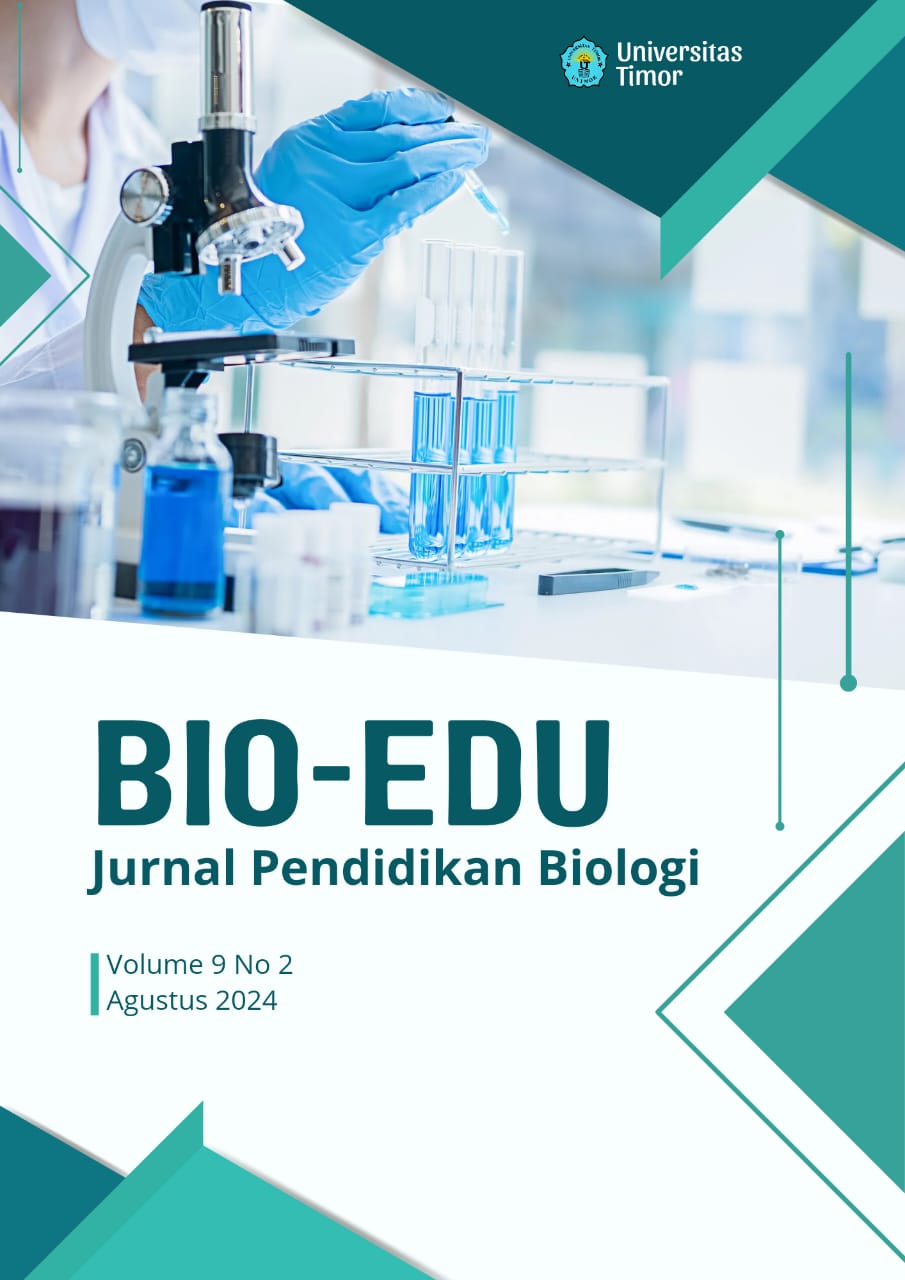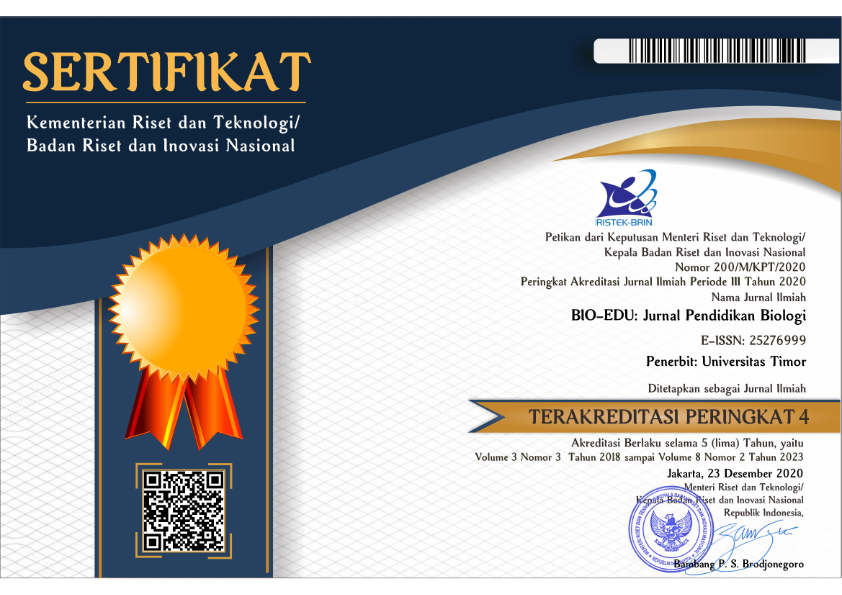The Influence of Audio Visual Learning Media Based on Life Skills Regarding Student Learning Outcomes
DOI:
https://doi.org/10.32938/jbe.v9i2.7163Keywords:
: learning, Life Skill Audio Visual Learning Media, Learning OutcomesAbstract
Learning requires interesting learning media that can support the theory taught by the teacher. This study aims to determine: the effect of using audio-visual media based on life skills on the learning outcomes of students of SMA Negeri 3 Fatuleu. The research method used experimental method with quantitative approach. The research design was pre-testposttest control group design. The study population was Class X IPA students of SMA Negeri 3 Fatuleu, totalling 26 people. The sampling technique was saturated sample technique. The instrument used was a test instrument in the form of a pretest and posttest. The data has been analysed using descriptive analysis with the help of SPSS. Based on the data analysis of the achievement of pretest learning outcomes with a percentage of 38% in the low category and posttest learning outcomes with a percentage of 72% in the very high category, it can be said that there is a very significant effect in the use of media, the t test shows that there is a significant effect on the use of life skill-based audio visual learning media in the learning process. Based on these facts, it shows that the influence of life skill-based audio visual media has a very good influence and can increase the level of understanding of students in understanding the concepts taught. The increase in learning outcomes is because by using existing media students are required to think actively, creatively and students must also draw conclusions from the material taught so that student interest in learning increases resulting in improved learning outcomes.
References
Anwar. 2012. Pendidikan kecakapan hidup (life skill Education). Alfabeta, Bandung. Anitah, Sri Surakarta. 2019. Teknologi Pembelajaran. UNS Press.
Fujianto, A., Jayadinata, A.K., & Kurnia, D. 2016. Penggunaan Media Audio Visual untuk Meningkatkan Hasil Belajar Siswa pada Materi Hubungan Antar Mahluk Hidup. Jurnal Pena Ilmiah. 1(1), 841-850
https://ejournal.upi.edu/index.php/penailmiah/article/view/3576
Hamzah. B. Uno, dan Nina, Lamatenggo. 2011. Teknologi Komunikasi dan Informasi Pembelajaran. Jakarta: Bumi Aksara.
Haryoko, S. 2012. Efektivitas Pemanfaatan Media Audio-Visual Sebagai Alternatif Optimalisasi Model Pembelajaran.5 (1) 1-10. Jurnal Edukasi Elektro.
Izzudin, A.M., Masugigo, & Suharmanto, A. 2013. Efektivitas Penggunaan Media Pembelajaran Video Interaktif untuk Meningkatkan Hasil Belajar Praktik Service Engine dan Komponen-komponennya. Automotive Science and Education Journal. 2 (2), 1-8 https://journal.unnes.ac.id/sju/index.php/asej/article/view/1910
Jihad, Asep dan Abdul Haris.2008. Evaluasi Pembelajaran. Jakarta: Multi Press.
Lestari, D.I. & Projosantoso, A.K. 2016. Pengembangan Media Komik IPA Model PBL untuk Meningkatkan Kemampuan Berpikir Analitis dan Sikap Ilmiah. Jurnal Inovasi Pendidikan IPA. 2(2) 1-11.https://journal.uny.ac.id/index.php/jipi/article/view/7280/0
Munandi, Y. 2012. Media Pembelajaran. Jakarta: Gaung Persada Press.
Odera, E. O. 2014. Impact of Audio-Visual (AVs) Resources on Teaching and Learning in Some Selected Private Secondary Schools in Makurdi. International Journal of Research in Humanities, Arts and Literature.
Prasetyo. Heri dan Nurhayati. 2015. Pengembangan Media Pembelajaran Interaktif Berbasis CAI (Computer Assisted Intruction) Pada Mata Pelajaran Teknik Elektronika Dasar Kelas X di SMKN 1 Nganjuk. Jurnal Pendidikan Teknik Elektro. 4(1),103-108 DOI: https://doi.org/10.26740/jpte.v4n1.p%25p https://ejournal.unesa.ac.id/index.php/jurnal-pendidikan-teknik- elektro/article/view/10403
Purwanto.2016. Evaluasi Hasil Belajar. Yogyakarta: Pustaka Pelajar.
Purwono, J. 2014. Penggunaan Media Audio-Visual Pada Mata Pelajaran Ilmu Pengetahuan Alam Di Sekolah Menengah Pertama Negeri 1 Pacitan. Jurnal: Teknologi Pendidikan Dan Pembelajaran. 2 (2)
Susilana, R. & Riyana, C. 2008. Media pembelajaran (hakikat, pengembangan, pemanfaatan, dan penilaian). Bandung: Jurusan Kurikulum dan Teknologi Pendidikan FIP – Universitas.
Utami. 2012. Pengembangan Media Pembelajaran Topologi Jaringan Komputer Berbasis Macromedia Flash Professional 8 untuk Siswa Kelas XII Multimedia di SMK Negeri 7 Yogyakarta. Skripsi, Universitas Negeri Yogyakarta.
Wahyuni, T., Widiyatmoko, A., Akhlis, I. 2015. Efektivitas Penggunaan Media Audio Visual pada Pembelajaran Energi dalam Sistem Kehidupan pada Siswa SMP. Unnes Science Education Journal. 4 (2) 998-1004. DOI 10.15294/USEJ.V4I3.8848
https://journal.unnes.ac.id/sju/index.php/usej/article/view/8848
Downloads
Published
Issue
Section
License
Copyright (c) 2024 BIO-EDU: Jurnal Pendidikan Biologi

This work is licensed under a Creative Commons Attribution-ShareAlike 4.0 International License.
The Authors submitting a manuscript do so on the understanding that if accepted for publication, the copyright of the article shall be assigned to BIO-EDU: Jurnal Pendidikan Biologi and Departement of Biology Education, Universitas Timor as the publisher of the journal. Copyright encompasses rights to reproduce and deliver the article in all form and media, including reprints, photographs, microfilms, and any other similar reproductions, as well as translations.
BIO-EDU journal and Departement Biology Education, Universitas Timor, and the Editors make every effort to ensure that no wrong or misleading data, opinions, or statements be published in the journal. In any way, the contents of the articles and advertisements published in BIO-EDU are the sole and responsibility of their respective authors and advertisers.
Users of this website will be licensed to use materials from this website following the Creative Commons Attribution-ShareAlike 4.0 International License.



















